Now this is going to be one heck of a polarising pushbike. Kudos to Cotic for continuing to plough their own furrow.
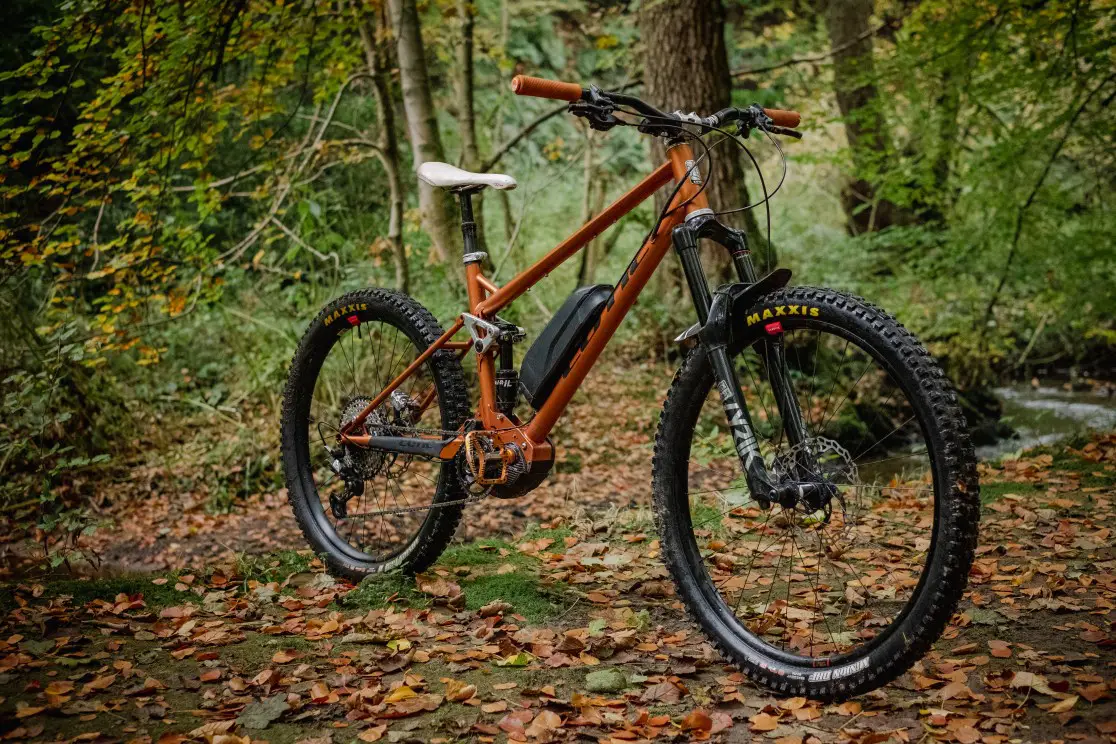
I, for one, am really pleased to see an external battery. I’ve been telling anyone who’ll listen this for the bulk of this year. Hot-swappable different capacity batteries make loads of sense. The vast majority of the excess weigh in ebikes is the battery after all. Have it as circa early 20s-kg bike for most rides. Swap in mega battery for some big mountain days on a 25kg beast.
I’m also pleased – and intrigued – to see a new rear suspension design. No Droplink here. It’s a linkage driven single pivot. Which means a straight and uninterrupted seat tube for decent dropper insertion.
p.s. don’t worry, the acoustic Cotic RocketMAX ain’t going away.
Cotic press release fest ahoy…!
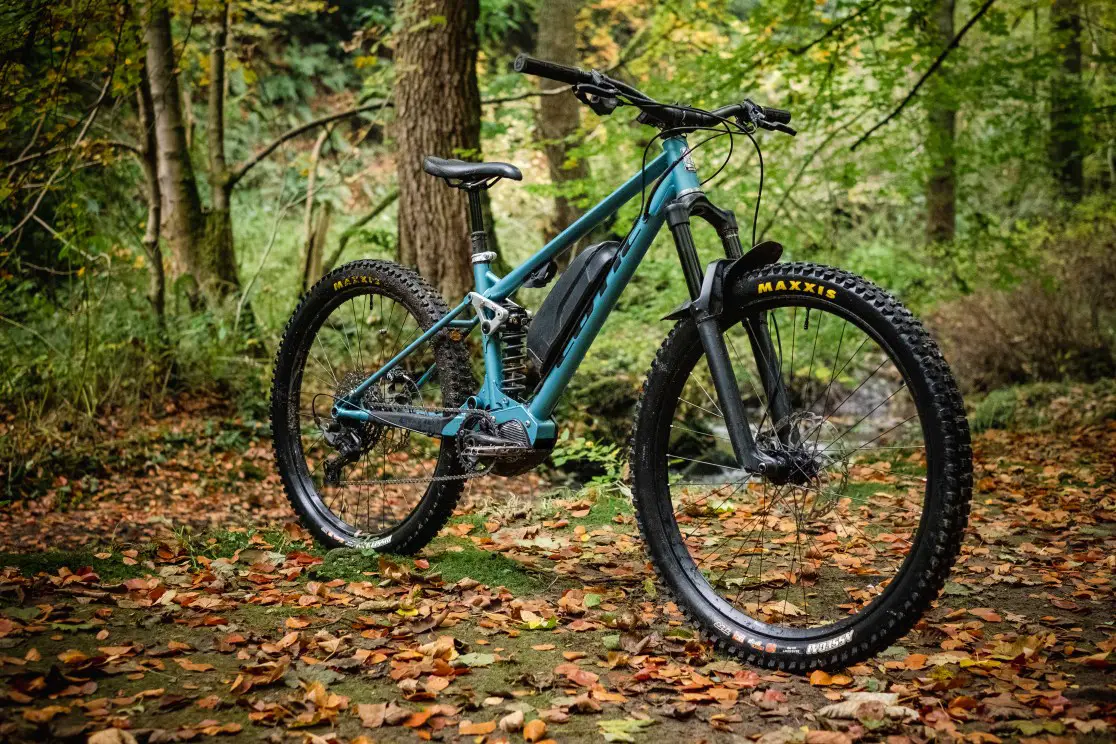
Cotic Rocket: Performance Steel Electrified
100% Hand Built in the UK, the Cotic Rocket is the world’s first high performance steel e-MTB. Fast ferrous fun.
The Rocket is everything you would expect from Cotic: Gorgeous ride feel, innovative steel design, lots of options to make it yours, fully UK made, all backed up with our legendary customer service.
It is a greatest hits of everything we have learnt over the last 21 years.
High End Steel, Made in the UK, Custom Build Options
The Cotic Rocket is the first premium steel ebike on the market. In 2003 we founded the company with the iconic Soul and brought modern thinking to steel hardtails. We did the same again with the original Cotic Rocket in 2012 by bringing steel to modern full suspension. Here we are again, bringing all of steel’s wonderful advantages to an ebike. It’s a clean sheet design with some new ideas to make one of the most useable ebikes on the market. This is what we do.
Every part of this frame was designed by us from scratch from first principles to realise our vision for the best e-mtb Cotic could make. For example, the bespoke Cotic designed and engineered motor mount saves nearly 1kg alone compared to off the shelf parts, and requires hours of fabrication. That weight saving transforms the ride of the bike. That’s just one thing. The shock has a unique floating bearing arrangement because it needed to be better than the ‘standard’ everyone else uses. The cable guides and motor cover are 3D printed to our exact requirements. That’s the level of detail.
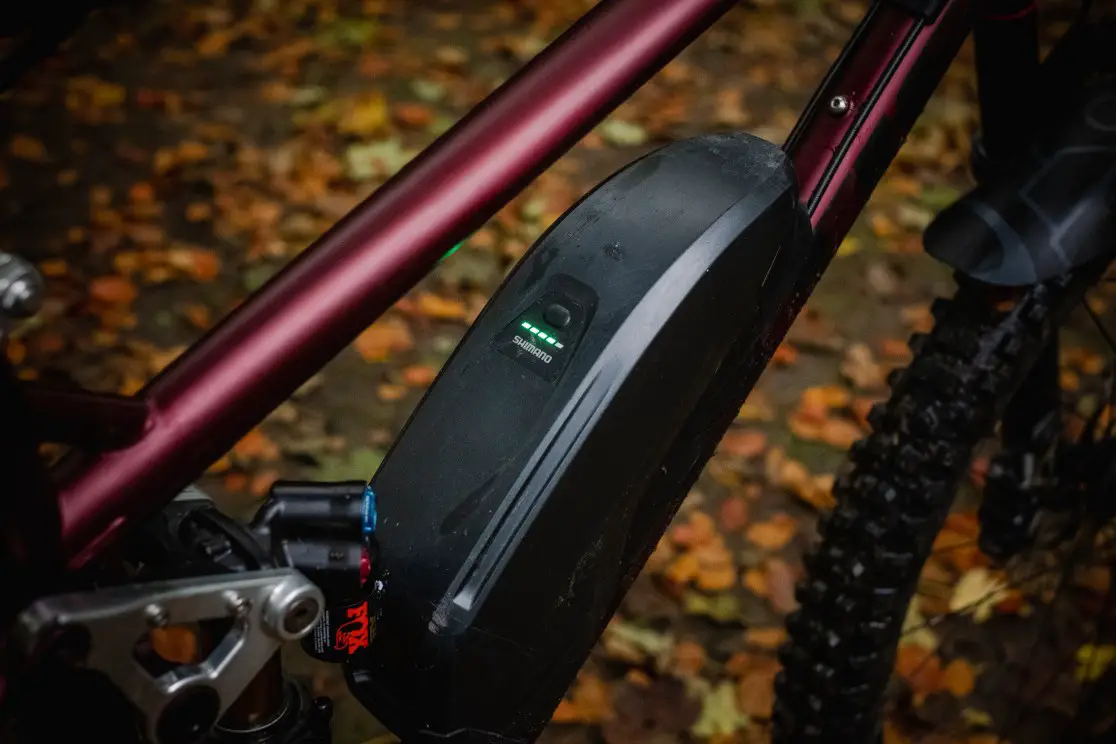
External Battery: Full Power or Lightweight? Why Choose?
Hot swap batteries in 10 seconds
The Cotic Rocket is the first fully configurable ebike. The practicality and ease of access to the external battery means you can set it up as a lighter, livelier ride with the small capacity 418Wh battery, go maximum range with the heavier 630Wh, or go in between with middle weight 504Wh. Because the external battery takes 10 seconds to remove and swap, you could easily run two batteries and simply swap them halfway through the day, or depending on your next ride. Best of both worlds.
The advantages don’t end there either: With the power button and charge plug on the battery itself, you can charge your battery safely and easily off the bike. There is also the added security of the bike being unusable whilst stored because you’ve taken it’s power source away.
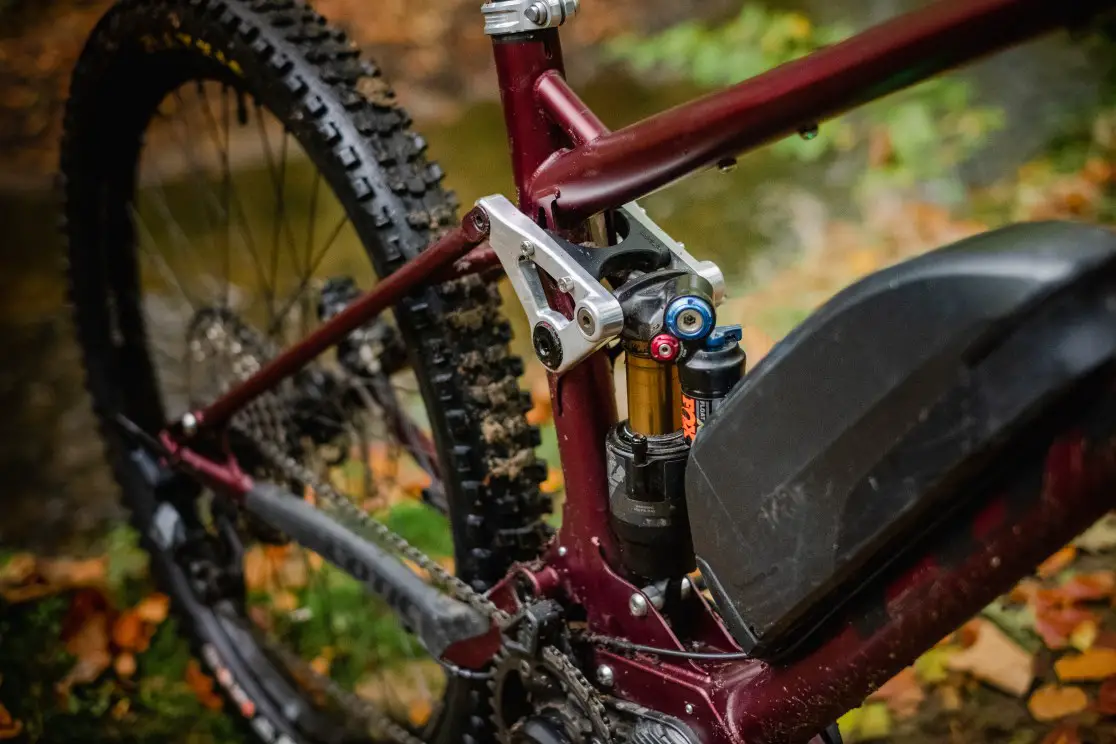
British Made, Limited Numbers
The whole frames are fabricated in small batches by some of the best makers in the country. They are a celebration of the beauty of welded metal. This is the antithesis of the mass produced homogeneity you see everywhere else. Bold use of material, skilfully wrought by people who care deeply about what they do.
Five Land Bikes make the steel elements of the frame. Matt and Callum are quite simply some of the best steel welders we have ever seen. The paint finish is unsurpassed and they have been bringing the small scale production expertise to Cotic suspension bikes since 2018.
Coal Bikes does the aluminium swingarm and are a key local Cotic partner, with Gavin having huge experience in the fabrication of all types. When he’s not making swingarms for the Rocket or his own frames, he makes our Escapade UK853 gravel bike frames too.
Rideworks do all the CNC machined parts for the rocker and swingarm. Paul and his team do their work with incredible precision and diligence.
76 Projects are our 3D printing partner, helping us with the custom motor cover and cable management parts. Rob’s been instrumental in helping us realise the parts we need to bring the level of detail we wanted for the Rocket.
Bear Frame Supplies are also local friends, based in the heart of the Peak District. Aaron makes the turned parts such as pivot bosses and axles that are key to the precise fit of all the moving parts of the frame.
Black Cat Custom Paint do all the A La Carte custom painting. Stu finishes frames to an incredible standard, so if you want to individualise your Rocket even further, he will be bringing your dream to life.
They are as beautifully built as they are great to ride, lap after lap.
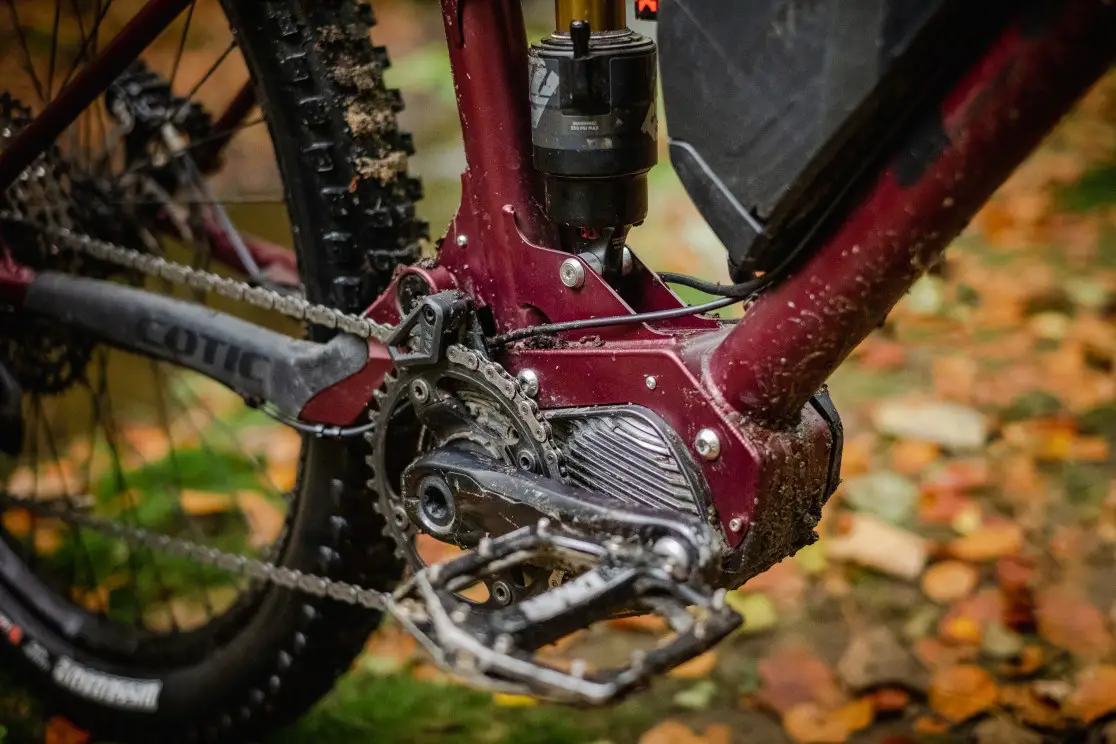
Electric Range and Performance
The Shimano EP801 power system gives you options from toned down, big ride “you on your best day” feel, right up to ‘giving it the beans’ 85Nm and 600W Boost. Choose Di2 electric shifting and you can add in Autoshift and Freeshift functionality. Cotic specified power profiles help you get the best out of your bike.
What does this mean in the real world? Even with liberal use of Trail and Boost power modes, the lightest 418Wh battery will easily do a 2-3 hour ride, 30-40km, 700-800m of climbing. I have eeked out 1100m out of his 418Wh battery and got back with 5% left, but that did briefly involve towing my riding buddy up a couple of climbs in Boost!
The large 630Wh battery will happily let you do as many laps of the hill as you can stand. Sam’s tested extensively up at the Golfie in Scotland, and ultimately his arms and ability to brain riding trails that hectic gave long before the battery did! For a different view on that, the big battery has taken us over 72km in rolling terrain on a big “look at the views” type ride as well. Ultimately, 1200-1500m ascent and 50-80km depending on power usage is easily achievable.
Through the development, we have all ridden lots on the earlier prototypes with 630Wh batteries, and regularly came back with 50% or more charge left. What’s the point in dragging the weight around when the lighter battery makes the bike so much more fleet footed? No need to make the choice with the Rocket. You can tailor your battery to your ride.
Why Shimano? Because it’s a fabulously natural feeling system, and with the latest firmware updates we strongly believe it’s one of the best ebike systems out there. With the Di2 integration we can offer autoshift and freeshift functionality, and the external batteries we needed are also lighter than most internal batteries, so there was an added performance benefit there too.
There is widely available warranty support through any Shimano dealer, and that will be backed up by Cotic holding parts stock as well to make sure customers have the least possible downtime should anything happen.
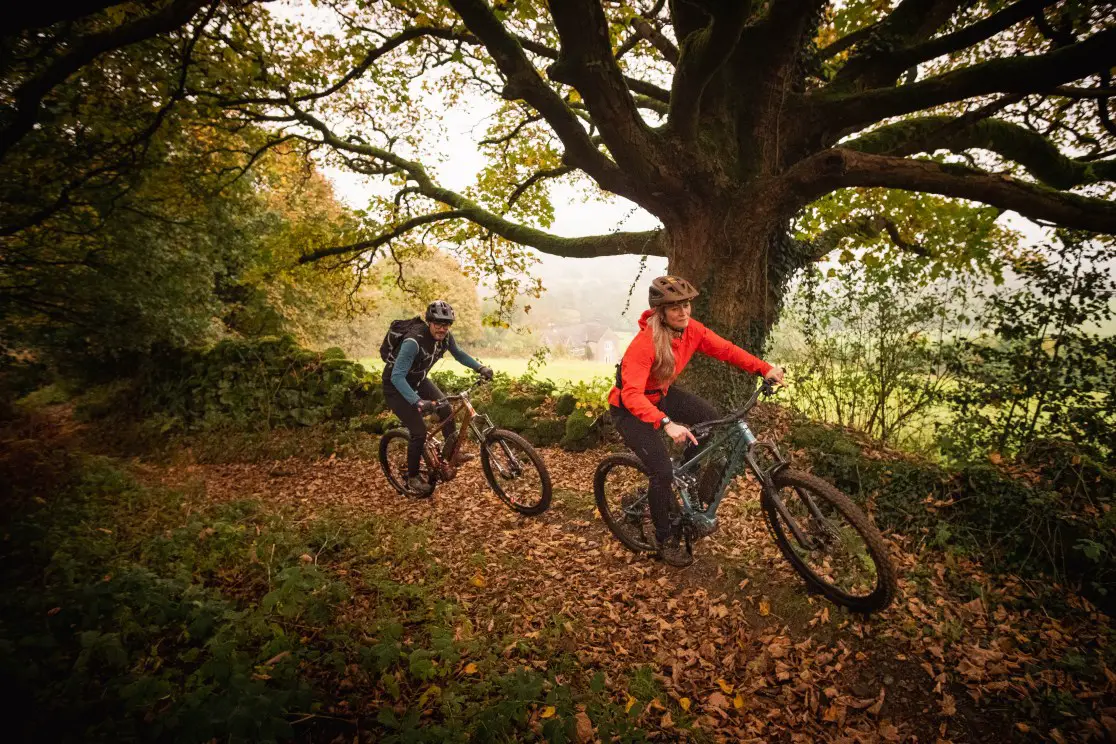
Suspension and Handling
Using an external battery keeps the steel tubing sweetly slim and able to deliver that beautiful, tactile ride feel ferrous frames are famous for. The front triangle is a unique blend of T45 roll cage tubing and Cotic exclusive Reynolds 853 to achieve the ride and toughness we were searching for.
The new rocklink suspension gives a lovely clean line to the frames, and packages the shock away from the battery. It’s developed from our well honed droplink design, with similar, well proven performance and kinematics transposed to the new shock location.
With 150mm of rear travel and 150 or 160 forks, it can be built light and lively for the trails and hills, burly and big for self-shuttle laps, or anything in between. However your build it, you’ll be having fun! Longshot geometry with proportional C-sizing has been developed over many years gives balance and poise you have to ride to believe. The handling on this bike is like a greatest hits of everything we’ve learnt over the last 20 years.
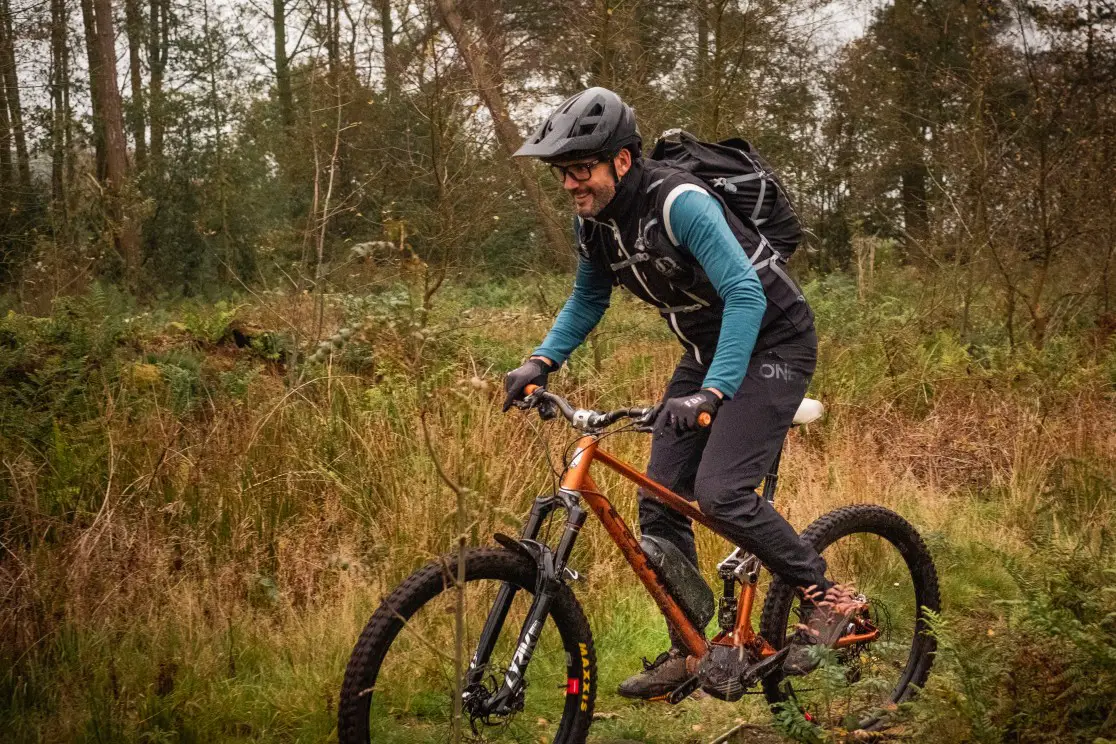
Pricing and Build Options
Complete Cotic Rocket builds start with the Gold build at £8,799. The combines Rockshox Ultimate fork of your choice (Lyrik at 150 or Zeb at 160), Cane Creek DB Air IL shock, Hope wheels, Shimano EP801 power system, Deore XT 12spd drivetrain, Magura MT7 brakes and Maxxis tyres. Shock, wheels, tyres and brake options abound, so this is really just a starting point.
Platinum builds are £10,999 with Fox Factory suspension, Reserve wheels, Shimano EP801 power system including Deore XT Di2 Linkglide electric drivetrain with autoshift and freeshift functionality, all rounded out with Hope finishing kit and brakes and Maxxis tyres.
We also have a frame only option. For £6,350 you get a Cotic Rocket frame, Cane Creek DB Air IL shock, full Shimano EP801 power system and XT cranks and chainring. You supply all the parts from your current bike, and we build them onto the frame and into a complete ebike. If you need some new parts to fit our frame, or you want to update a few things, just let us know. The only fixed point with the frame only option is that we have to build and sign off a complete, functional ebike before shipping it.
These are just starting points though. We can flex specifications up or down, tweak suspension options, supply extra batteries. There’s even our A La Carte custom paint options for just £50 extra. Now, more than ever, this is Your Bike Built For You. Our amazing team will look after you through the whole process and make sure you get your dream bike at the end of it.
Orders are open now for placing deposits. We will be delivering production bikes in April 2025.
+++
The Cotic Ebike Story
Let me tell you the story of the Cotic ebike. It started back in 2019, when we realised that ebikes were definitely going to be A Thing, and we should look into what a Cotic ebike might be.
We’ve never been ebike haters; they’re just another way to enjoy our brilliant sport, and for some people, a much easier way to get involved or continue to ride.
Back then, the main new hotness in ebikes was the move away from external batteries to internal ones. There was no such thing as mid-power or lightweight bikes, just ebikes with ever bigger capacity batteries. Given this was the current state of the market, putting a battery inside a steel tube or structure just wasn’t going to work. At these large sizes, steel would be horribly, horribly stiff. Steel only really works when it can be used in relatively small sections. Remember this point, we’ll be coming back to it later!
So, I chose an aluminium tubeset from our frame vendor that could fit the Shimano ebike drive system because we already had a great relationship with them, and warranty support would be there through Shimano dealers.
I felt the best place to start would be to build an ebike as close to a regular Cotic as possible, and when we discussed the project we decided we wanted to start with a trail bike rather than go Full Enduro. Although we love a bit of Winch and Plummet style riding that is so well facilitated by ebikes, ultimately most of us just like riding in the hills, so that’s where we started. As it happens the first black, aluminium ebike prototypes shared a lot of their geometry with the bike that became the Jeht. It was a 140/150 29er with Longshot geometry, with a version of Droplink suspension. I even snuck some steel seatstays in to keep it a bit more Cotic.
I signed the drawings off in September 2019. Then Covid hit, and everything kind of stopped. We didn’t get the first prototypes until November 2021. We made these public in early 2022.
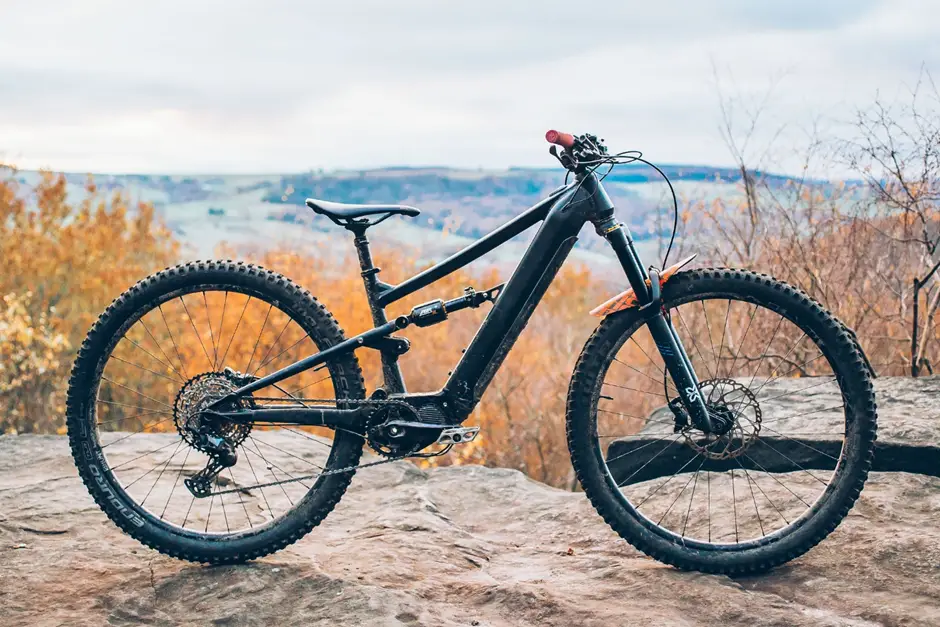
We built them and swore extravagantly and excessively at the internal hose and cable routing. We marvelled when we plugged all the Di2 wires into random ports in each part and the bike Just Worked. We rode them a lot and tried out a lot of different configurations. We learnt. The most important thing we learnt was we needed them to be mixed wheel/mullet. With a big heavy down tube housing a big heavy battery, getting the bike into corners in the full 29 configuration was quite tricky. You have several kilos of structure concentrated in front of your feet and it didn’t like being leaned over once it had some momentum! Using different length shocks, offset bushings, and 27.5 rear wheels, we mostly maintained the geometry, but found the easier turn initiation you get with a mullet setup massively improved the handling of the bikes. They almost dived into turns because now the weight was working with you. They were really good bikes, just a steeper seat angle and a couple of geometry tweaks away from being right. They definitely had that “runaway train” feel to them that all big power, big battery bikes seem to have, being as they were around 25kg in weight. More power and more battery seemed to be the dominant themes in the market at that time, so we carried on developing the bikes in this direction.
We couldn’t afford to wait another 2 years for our frame factory to make more prototypes, so I had Five Land Bikes (our Scottish framebuilder for all the droplink bikes) build me a steel geometry test mule using the external batteries that Shimano have as part of their STEPS system. This is what became known as the Rhubarb and Custard bike.
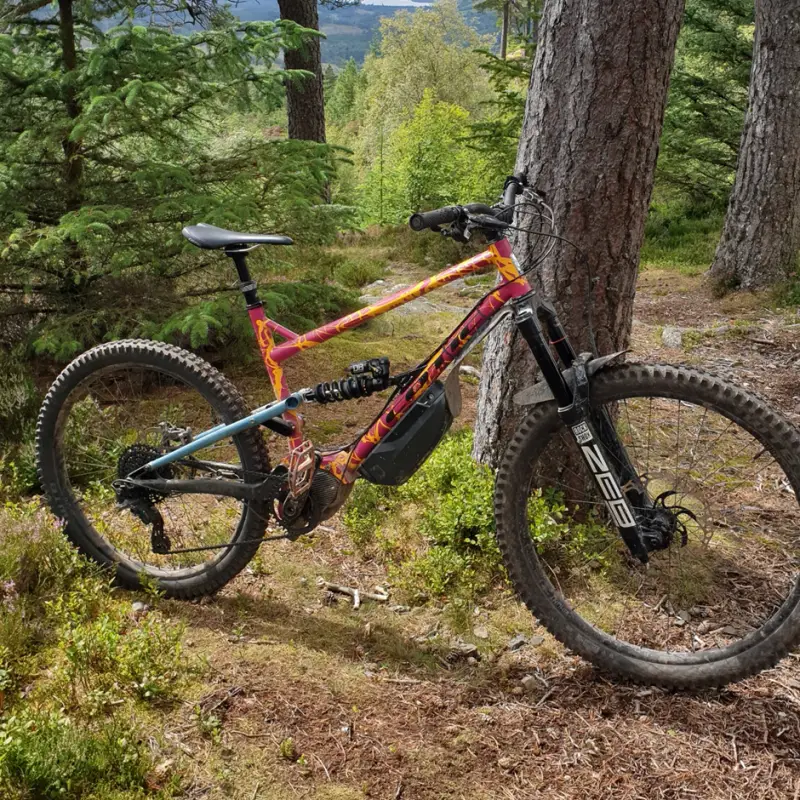
The Rhubarb bike used broadly a RocketMAX Gen3 front triangle with an off the shelf cast steel motor yoke. The travel was bumped up to 150/160, with geometry dedicated to a 27.5 rear wheels. It used the rear end from one of the first prototypes, and to accommodate the droplink suspension it slung the Shimano external battery under the down tube. The eponymous paintjob was the result of me saying “whatever is left in the gun” when asked what colour I wanted it! It arrived in March 2022, just 7 weeks after I completed the drawings. The beauty of UK made….
We posted photos on a blog about the bike and my Shimano contact emailed me immediately saying “you can’t make that!!!”. I think he thought it was going into production, but that was never the intention. Aside from Shimano (quite fairly) not wanting their battery in the firing line of the front wheel on a mountain bike, the only reason it worked is because it was an XL size for me. The front wheel would have hit it at full compression on anything smaller. That said, I never had a single issue with the battery in that location in 2 years of running that bike.
Time moved on, the market moved quickly, and we started thinking we might need a bigger battery than the 630Wh Shimano could supply. The market for full power bikes was demanding ever more capacity, despite the fact that we almost never ran out our 630Wh batteries. Most times on the local blasts would barely use 50% of them. We started talking to a battery supplier who – amongst others – supply the 720Wh battery in the Santa Cruz bikes. We had a new aluminium down tube put into the bike to fit the bigger battery. I had settled on a geometry (basically RocketMAX). We were all set to get going in summer 2022 when we asked Shimano when we could get drive systems. “Erm…..2024 maybe?”. Oh….
So the project was put on hold for a while until we could get a firm delivery date on drive systems. Chief Mechanic Will used one of the original prototypes as his main bike. The other two aluminium bikes were regularly borrowed and feedback logged. I continued to ride, adjust and understand the Rubarb bike. I tweaked the handling and kinematics with little shock yokes, seatstays and all sorts. It was going the right way up to a point, and I have to say I never fully ‘solved’ that bike. I didn’t love it. I learnt a lot though.
All the time through this, whoever saw the aluminium ebike prototypes understood what they were and why we’d done it, but most people who knew Cotic expressed some level of regret that it wasn’t steel. And people loved the Rubarb bike whenever I posted photos.
The other thing that was happening was the mid-power/lightweight ebike side of the market was exploding. One of the main reservations we had about our ebike prototypes was the weight. That “runaway train” feeling as we call it. We had a good chat about it between us one morning in Spring 2023 and all decided that on balance a lighter bike with a smaller battery might suit most of us better.
Related to this, lighter, less strong riders found the big bikes hard to manage, even when riding flow trails. Both my teenage daughters rode the prototypes. Neither would consider themselves at all interested in pedalling, which is why I got them to ride the ebikes, but they both really didn’t like trying to ride them down a blue, bermed flow trail. Too heavy, too much “bike riding them”. They’re not super into riding, but given they’ll both happily ride laps of the flow trails at Bike Park Wales all day long regardless of conditions on their FlareMAX’s, their opinion was worth noting.
Fortunately the battery vendor we were talking to also had the lightest 400Wh battery on the market in their range, and it was Shimano compatible. I had my agent in Taiwan send me over the information and a smaller aluminium down tube to put it in. I imported it into Solidworks (my 3D CAD software) and just did a weight check on it. 850 grams. Eh? I checked again. Definitely 850 grams. This struck me as ‘not very light’. I always understood that the big down tube with the hatch in for the big battery would be heavy. It’s not really a tube, so not very efficient, so that weighing 1.2kg plus battery hatch was understandable, albeit not desirable. This so-called lightweight solution was 20% heavier than a RocketMAX down tube. The same down tube I built Neko’s steel Frameworks x Cotic DH bike out of, so not exactly sylph like!
This started me on a train of thought. I already had an external battery, and it had been fine. Better than fine, it had been really useful. Much simplified wiring on the bike because the charge plug and on/off switch are on the battery. I can remove it in 3 seconds for washing the bike, or charging indoors in cold weather or when on a trip. I had also noticed that the Shimano external batteries are quite a bit lighter than the internal ones for some reason. The 630Wh external battery I have is 0.5kg lighter than the internal fit version. The really interesting thing was that they did a 418Wh external battery at a really good weight. A weight so good that when I added up a steel down tube, mounting kit and battery it was barely any different to the weight of the so-called ‘lightweight’ aluminium setup with all it’s associated gubbins. The added bonus of using an external battery is modularity: The Shimano external mount let’s you fit 418, 504 or 630 Wh batteries, and let’s you swap them in seconds.
I start on some steel frame layouts that would allow for a down tube mounted battery, same swingarm geometry and pedaling kinematics as the prototypes we knew and had tested. I was getting more and more excited about the possibilities of this mostly steel ebike. It would be a regular sized steel down tube. Not only a good weight, but with nice stiffness. I could get some feel back into this bike! (See, I told we’d come back to it). Steel would also allow us to build in the UK, which is a big plus. Smaller batches, more control, shorter lead times, shorter supply lines. All good.
The next thing I ran into was the motor yoke. The cast steel off-the-shelf yoke weighed nearly 1.4kg on it’s own. The aluminium yokes aren’t exactly light either (nearly 0.8kg), but this cast yoke really was preventing me from making the steel idea sing. So I designed my own. It using high strength plate, laser cut and then welded together by Five Land. It’s quite a lot of work to make, but it saves nearly 1kg!
All through this period of design, I was still struggling to love the Rubarb bike. The particular nadir came back in January with a ride through a typically janky Wharncliffe with my friends on their SL ebikes. I got back from the ride having been frustrated with the bike. It was too heavy to hustle through technical trails. Too low on the BB, and too slack and slow witted. It didn’t inspire confidence. Whilst it was great to be out with my mates, and my legs weren’t tired despite over 1400m of vertical, my shoulders were sore for days and I didn’t feel like the riding had been much fun.
The reason I’m telling you this is because, through getting some external help with the FEA (stress analysis) of the new steel yoke and front end designs, I began to understand some of the reasons I couldn’t ‘solve’ the Rubarb bike. A significant issue was stiffness. Now, I love a bit of frame flex. Give along the length of the bike is what I live for in bike design. Juuuuuust enough to breathe with the trail and give you that beautiful, tactile Cotic ride feel. The thing with the Rubarb bike was that, despite having a very strong front end, it wasn’t stiff enough once you strap a few kg of motor and battery to it.
Whilst refining the motor yoke, we realised even the current Gen4 RocketMAX down tube wasn’t going to be stiff enough, so the down tube went up in diameter. The aim was always to tie things down just enough though. If we’re doing steel, it’s getting ride feel! In the end we settled on a tube that is stiffer than the RocketMAX tube, and managed the lumps of mass of the battery and motor. It was still less than half the overall frame torsional stiffness of some of the ebikes my FEA guy had seen and worked on. Turns out most ebikes are unbelievably stiff!
I also went back to those first ebike chats we had right at the start of the project. I had clearly gone too low and slack on the Rubarb bike for the kind of riding I wanted to enjoy, so the BB needed raising and head angle steepening to get something with a more all round sensibility. The geometry was again loosely based on the Jeht – this time the current version – but accounting for the 160mm ebike cranks, and a couple of other tweaks.
It would be 150 rear with 150 or 160 fork capability, in keeping with the modular theme from the batteries. Go trail or enduro style.
Longer chainstay to bring more forward weight shift to the bike.
Still dedicated mullet, because despite the option for lighter batteries I still felt this held an advantage for ebikes.
With the need to adopt a rocker link setup to avoid the down tube mounted battery, I went back to the progression rate similar to the original black aluminium prototypes. They worked great, and nothing I’d done with the Rhubarb bike had found anything better.
I got to a workable design for prototyping in March this year (2024). The projected weight looked good. The bike looked good, and I was excited to see what we had built. Five Land did a stellar job of building us three prototypes in 3 different sizes. They re-used the original swingarms for speed, but all other parts are new.
At the end of July we built them up and finally the moment of truth arrived. For a start, they looked amazing! So Cotic, so clean. Because most of the cable and hose routing and battery mounts are external, it was sooooooo easy to build and work on compared to the first prototypes. Even the internal dropper/control wire routing was really easy. Oh my goodness if you work on your bike, this is the ebike for you!
The only things that tripped us up on the builds was needing to tweak the 3D printed covers and cable guides. This is why we prototype. Because the steel yoke is so compact compared to other materials, and no one else is building premium steel ebikes, I’ve had to design our own covers and closure plates and hose/cable management. 76 Projects have been brilliant supporting me on this, and the joy of 3D printing is that it’s so fast to tweak and try new designs. The final parts work great for routing the cables and wires, and keeping the filth off the electrics. Jagwire completed the picture with perfect clips and sheaths to hold the Di2 wires in place.
The weight of the bikes is definitely in the game. My C5 prototype first build, with all aluminium finishing kit, WTB wheels, Magura MT7 200mm brakes, Maxxis EXO+ casing tyres and Lyriks weighed in at 21.5kg with the 418Wh battery. That’s a full power bike, with nothing fancy, no carbon bits. It’s 22.3kg with the 630Wh. I reckon there is a fairly easy 0.5kg to knock off without going silly with expense too. And certainly no carbon. We don’t do carbon, you know that.
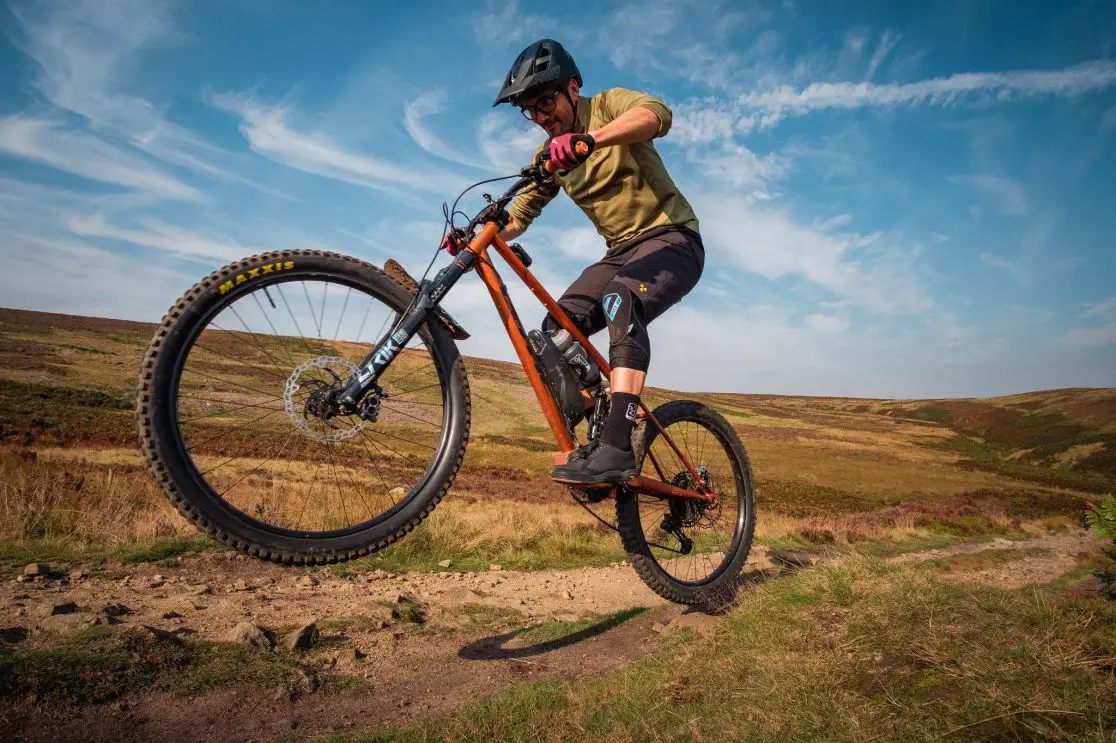
At this point, you might be wondering why a man who has spent the majority of his working life designing steel bikes and telling people not to be so worried about weight is suddenly so obsessed with it? With ebikes, when they weigh up over 24-25kg, they just don’t really feel like bikes anymore. They’re a lot to manage. If you want that experience, great, but it never quite gelled with all of us. There seems to be something of a tipping point where ebikes go from “easy to handle” to “a lot to manage”. Based on our testing, that point appears to be around 22kg with a relatively light battery and frame.
We’re never going to win any weight contests, but I also think a lot of the very light ebikes out there are under-powered, under-spec’d (particuarly tyres and brakes) or both. This is a full power, useable, durable, tough bike with wonderful ride feel. That was the aim of the project, and I think we’ve achieved that in the most Cotic way possible.
We have now tested the new bike extensively with the 418Wh and 630Wh batteries.
With the 418Wh battery, it’s not just like a regular bike, but it’s close enough that your braking points aren’t off, and you’re not feeling like you’re managing the weight. It’s just a really fun bike to hustle, with the added bonus of having 85Nm/600W Boost to whiz you back up the fireroad to the top!
The 630Wh battery definitely needs a little more compression damping to manage the weight through big compressions, and it does occasionally feel like a lot of bike when you really get trucking in steep terrain, but it’s way more manageable than the previous bikes with the bigger batteries.
And what about the handling? The ride? The FEEL?! Well, I am very pleased to tell you that it’s all there in spades. It’s one of the most fun bikes we have ever built. It feels like a Cotic. It feels so balanced and intuitive and confidence inspiring. It’s such a good climber, and not just because of the motor! The mullet energised turn in and cornering stance feels brilliant, and you can adjust the pressure on the tyres so nicely.
On that fateful ride back in February we rode a particular trail called 4 Turnips. It’s quite flat, janky as all hell, poorly sighted rock rolls, the lot. I normally really enjoy it. It challenging and you need to move the bike around to make it work. It was horrible on the Rubarb bike. It was too heavy to lift and move. Too low so I wasn’t confident on the rock rolls. The slack head angle combined with the weight made it ponderous for the slower techy bits. I rode it a few weeks later on the FlareMAX and it was brilliant, despite the weather being that particularly sideways British rain. I’ve had fun riding my RocketMAX through there too, so it’s not necessarily super slack geo, but weight and height were definitely not my side with old Rubarb.
I’ve since ridden 4 Turnips twice on the new bike, and it’s fantastic! It dances where the other prototypes bogged and smashed, and I had a ball riding it through there. I know it’s unbelievably local and specific, but if I could tell you nothing else about this ebike, the fact that it passes the 4 Turnips test is very important!
Most of our bikes are still running the old generation Shimano EP8 drives and we have had very little trouble with them. My external battery has certainly proven more than weatherproof, having basically acted as a mudguard on Rubarb for 2 years! For the last few weeks I have been running the latest EP801 system and firmware, and it’s quite the revelation in terms of performance and tuning. The extra run on function I now have is particularly fun for my current favourite sport of riding my usual loop backwards, so all the downhills are deliciously technical uphills. We’re stoked to be running the Shimano kit.
What about range? I’m getting between 700 and 1100m vertical out of the 418Wh battery depending on how much I eek it out. Sam took the modularity idea and went to the burlier end of the scale on the C2 prototype, with 160mm Zebs, sticky Michelin tyres, bigger brakes and the Linkglide Shimano CUES drivetrain. He took the 418Wh battery to the Golfie and did two days testing prior to the demo we did a few weeks ago. The little battery was easily good for 4 full laps in 2 hours in the hammering rain, which as Sam says “is about all my brain can brain in one go in those weather conditions!”. It was an easy 5 laps in the dry the following day.
If you could process more laps or wanted to use more Boost, you could go with the bigger battery. My personal favourite strategy is to have a second 418 or 504Wh battery in the van. Use up one in the morning, go grab some lunch, 10 second battery swap because it’s external, away you go all afternoon.
On big mountain days you could stash the second battery in a pack and take it with you. They only weigh 2.5kg. Suddenly you’ve got a reasonable weight, full power bike that dances and jinks instead of ploughing and plodding, but with 836Wh or over 1000Wh of battery capacity accessible with a hot swap on the trail.
Because of how easy it all it to access and work on, you could even whip the battery mount off and unplug it from the motor for uplift days so you’re not heaving that extra few kg onto the uplift trailer. It only takes 10 minutes. If you’re doing a lifts and bikeparks trip to the Alps this would allow you to fly with your unpowered bike without running into any battery shipping issues. There are SO many reasons why having the battery on the outside is great.
So that’s the story of the first Cotic ebike. It’s been a journey, but the bike has been worth it. It’s ace. I hope you like it too.
Cy Turner
Founder and Director, Cotic Bikes


Home › Forums › New Cotic Rocket is a steel frame ebike with external battery
You must be logged in to reply to this topic.
Spread the word:
Spread the word: